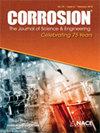Mechanisms of environmentally induced crack initiation in humid air in new generation Al-Zn-Mg-Cu alloys
IF 1.1
4区 材料科学
Q4 MATERIALS SCIENCE, MULTIDISCIPLINARY
引用次数: 0
Abstract
Recent experience has shown that new-generation 7xxx-series alloys, that have a high Zn content and Zn/Mg ratios, have a greater susceptibility to Hydrogen-Environmental Induced Cracking (H-EIC) on exposure to humid air than more established materials, like AA7050. In this study we report new evidence of the EIC initiation and crack growth behaviour of two new generation alloys, AA7085 and AA7449, when exposed to 50% humidity. In-situ, time lapse, optical imaging over large areas has enabled the exact initiation sites to be identified and investigated with high-resolution fractographic studies, providing evidence for the sequence and mechanisms of initiation and transition to sustained cracking. A consistent behaviour was observed for both alloys. This has revealed that only minute-scale corrosion reactions, involving highly localised condensed water, are necessary for initiation. The preferred initiation sites are metal ligaments between surface-connected pore-clusters and/or intermetallic particles that are subjected to high stress concentration and undergo mechanical damage with associated higher levels of local oxidation. The growth of short proto-cracks from these sites is a distinct stage and displays intermittent arrest markings evidenced by localised corrosion. In contrast, in humid air environments, long cracks in these alloys exhibited relatively constant, higher velocity, with extremely limited corrosion commensurate with oxidation of a free surface in this environment resulting in ~5 nm oxide layer.新一代Al-Zn-Mg-Cu合金湿空气环境致裂纹萌生机理
最近的经验表明,具有高Zn含量和Zn/Mg比的新一代7xxx系列合金在暴露于潮湿空气时比更成熟的材料(如AA7050)更容易发生氢环境诱导开裂(H-EIC)。在这项研究中,我们报告了两种新一代合金AA7085和AA7449在暴露于50%湿度时的EIC起始和裂纹扩展行为的新证据。大面积的原位、延时、光学成像技术使得精确的起裂位置得以确定,并通过高分辨率断口学研究进行调查,为起裂和向持续裂缝过渡的顺序和机制提供了证据。观察到两种合金的行为一致。这表明,只有涉及高度局部冷凝水的分钟级腐蚀反应才需要引发。首选的起始点是表面连接的孔簇和/或金属间颗粒之间的金属韧带,这些金属韧带承受高应力集中,并遭受机械损伤,伴有较高水平的局部氧化。这些地方的短原裂纹的生长是一个明显的阶段,并显示间歇性的停止标记,这是局部腐蚀的证据。相比之下,在潮湿空气环境中,这些合金的长裂纹表现出相对恒定的、较高的速度,在这种环境中,自由表面的氧化产生了~5 nm的氧化层,腐蚀非常有限。
本文章由计算机程序翻译,如有差异,请以英文原文为准。
求助全文
约1分钟内获得全文
求助全文
来源期刊

Corrosion
MATERIALS SCIENCE, MULTIDISCIPLINARY-METALLURGY & METALLURGICAL ENGINEERING
CiteScore
2.80
自引率
12.50%
发文量
97
审稿时长
3 months
期刊介绍:
CORROSION is the premier research journal featuring peer-reviewed technical articles from the world’s top researchers and provides a permanent record of progress in the science and technology of corrosion prevention and control. The scope of the journal includes the latest developments in areas of corrosion metallurgy, mechanisms, predictors, cracking (sulfide stress, stress corrosion, hydrogen-induced), passivation, and CO2 corrosion.
70+ years and over 7,100 peer-reviewed articles with advances in corrosion science and engineering have been published in CORROSION. The journal publishes seven article types – original articles, invited critical reviews, technical notes, corrosion communications fast-tracked for rapid publication, special research topic issues, research letters of yearly annual conference student poster sessions, and scientific investigations of field corrosion processes. CORROSION, the Journal of Science and Engineering, serves as an important communication platform for academics, researchers, technical libraries, and universities.
Articles considered for CORROSION should have significant permanent value and should accomplish at least one of the following objectives:
• Contribute awareness of corrosion phenomena,
• Advance understanding of fundamental process, and/or
• Further the knowledge of techniques and practices used to reduce corrosion.
 求助内容:
求助内容: 应助结果提醒方式:
应助结果提醒方式:


